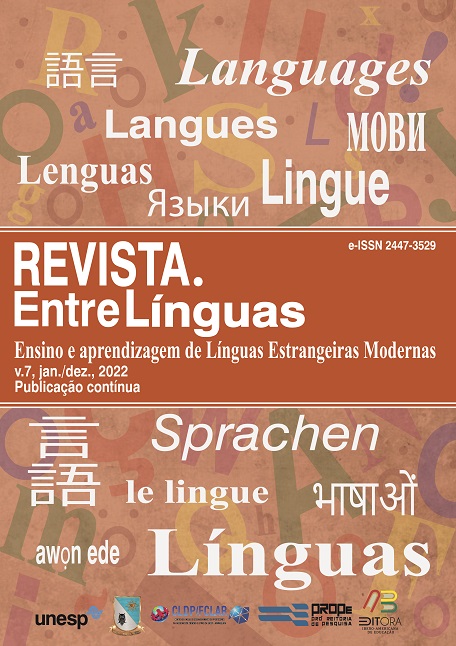Code-switching from french into english as a reflection of personalization function in Netflix series “Emily in Paris”
DOI:
https://doi.org/10.29051/el.v8i00.16888Keywords:
Basic verbs, Code-switching, English, Emily, FrenchAbstract
The plot of the series “Emily in Paris” is rather simple. It also should be noted that most of the people “Emily” meets are able to converse in English, but find it hard to find equivalents in English for their speech. We should cite first as an example the word “la plouc”, which is used as a reference to Emily’s New York style and manners. It can be translated as “country girl”. “Bonjour, la plouc!” The second French word, which follows Emily is “ringarde”, common in English. A French designer, who sees a fluffy accessory attached to the bag, calls Emily “common”. It is recommended that further research of Code-switching (CS) in series language will be made to examine speaker’s intentions in a larger sample of inclusions, as well as their syntactic structure, semantics, and psychological motivation.
Downloads
References
BENSEN, H.; ÇAVUSOGLU, C. Reasons for the teachers’ uses of Code-switching in adult EFL Classrooms. Hasan Ali Yücel Eğitim Fakültesi Dergisi Sayı, v. 20, n. 2, 69-82, 2013. Available in: https://www.hayefjournal.org/Content/files/sayilar/63/69.pdf. Access in: 12 mar. 2021.
BILÁ, M. KAČMÁROVÁ, A. VAŇKOVÁ, I. What is behind the compiling of a dictionary for a bilingual user. In: KIELTYKA, R.; UBERMAN, A. Evolving Nature of the English Language. Franfurkt: Peter Lang, 2017. Available in: https://www.researchgate.net/publication/314402513_What_is_behind_the_compiling_of_a_dictionary_for_a_bilingual_user. Access in: 17 Jan. 2021.
CLYNE, M.; NORRBY, C.; WARREN, J. Language and Human Relations Styles of Address in Contemporary Language. Cambridge: University Press, 2009.
DELA, R. R. “Discourse Matrix in Filipino- English Code-Switching: Students' Attitudes and Feelings.” i-Manager’s Journal on English Language Teaching, v. 6, n. 4, p. 13-18, Oct./Dec. 2016. Available in: https://files.eric.ed.gov/fulltext/EJ1133193.pdf. Access in: 15 Nov. 2020.
ELIZABETH, A. Understanding the Experiences of Bilingual, Latino/a Adolescents:Voices from Gifted and General Education. Roeper Review, v. 29, n. 3, p. 174–182, 2007. Available in: 17 Fev. 2021.
EMILY IN PARIS. Los Gatos, CA: Netflix, 2020. Available in: https://www.netflix.com/title/81037371. Access in: 12 Ago. 2021.
GARCÍA, O.; LIN, A. M. Y. Bilingual and Multilingual Education. Germany: Springer, 2016.
GUMPERZ, J. J. Discourse Strategies. Cambridge: Cambridge University Press, 1982.
LESHCHENKO, Y.; DOTSENKO, T.; OSTAPENKO, T. Cross-Linguistic Collocations Used by Bilingual Native Speakers-A Case Study of Komi-Permyak-Russian Bilinguals. Athens Journal Of Philology, v. 5, n. 4, p. 301–316, 2018. Available in: http://www.athensjournals.gr/philology/2018-5-4-3-Leshchenko.pdf. Access in: 17 Out. 2020.
LEVELT, W. J. M. Speaking: From intention to articulation. Cambridge, MA: MIT Press, 1989.
LEVELT, W. J. Speaking: From intention to articulation. Cambridge, MA: MIT press, 1993.
TUTOVA, E. Code-switching in French lexico-phraseological units in the English-language publicistic discourse. Thesis (Ph.D in Philology) – Moscow, 2017.
WEI, L. Cross-Linguistic Influence in Third Language Acquisition: Psycholinguistic Perspectives. Lingua, v. 113, n. 2, p. 183–186, 2003. Available in: https://www.sciencedirect.com/science/article/pii/S0024384102000669?via%3Dihub. Access in: 17 Mar. 2021.
Published
How to Cite
Issue
Section
License

This work is licensed under a Creative Commons Attribution-NonCommercial-ShareAlike 4.0 International License.
Os manuscritos aceitos e publicados são de propriedade da Revista EntreLínguas. Os artigos publicados e as referências citadas na Revista EntreLínguas são de inteira responsabilidade de seus autores.
Transferência de direitos autorais – autorização para publicação
Caso o artigo submetido seja aprovado para publicação, já fica acordado que o(s) autor(es) autoriza(m) a UNESP a reproduzi-lo e publicá-lo na EntreLínguas, entendendo-se os termos “reprodução” e “publicação” conforme definição respectivamente dos incisos VI e I do artigo 5° da Lei 9610/98. O artigo poderá ser acessado pela rede mundial de computadores (Internet), sendo permitidas, a título gratuito, a consulta e a reprodução de exemplar do artigo para uso próprio de quem a consulta, desde que haja a citação ao texto consultado. Essa autorização de publicação 328 EntreLínguas, Araraquara, v. 1, n .2, p. 323-328, jul./dez. 2015 não tem limitação de tempo, ficando a UNESP responsável pela manutenção da identificação do(s) autor(es) do artigo. Os artigos publicados e as referências citadas na Revista EntreLínguas são de inteira responsabilidade de seus autores.











